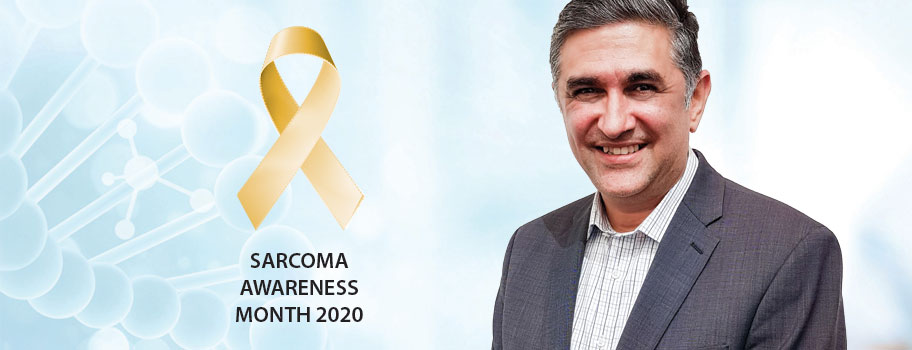Sarcoma Awareness Month: A/Prof Jayesh Desai
Australians who are diagnosed with sarcoma have around a 70% chance of complete cure if they are diagnosed early, according to one of the country’s leading sarcoma experts. Associate Professor Jayesh Desai says making a correct diagnosis at early stage - before the cancer has spread to other organs - is crucial to helping patients make a complete recovery. To mark Sarcoma Awareness Month, he shares some of his insights.
“Sarcoma represents only 1% of all cancers. Although they are rare, with many patients never having heard of them before they are suddenly given this diagnosis, expert care is well set up in Australia with specialty centres in each of the capital cities. They can strike people at any age, but if a young person is diagnosed with cancer, in a significant number of cases it will be a sarcoma.
We know sarcoma is not just one disease; there are around 100 different sub-types. Sarcomas can be found in the soft-tissues or in the bone. Some rare sarcomas have known causes, but in the vast majority of cases, the cause is unknown. About 20% of soft tissue sarcomas are called leiomyosarcomas and between 30 and 40% are liposarcomas. So, in the world that I live in, these soft-tissue sarcomas are very common. And the people diagnosed with these types of sarcoma tend to be what I call ‘young middle aged’.
What would I say to someone diagnosed today? I would say that it is critically important you get expert help early. Outcomes are so much better when patients are referred to a specialist multidisciplinary unit early.
Sometimes this is hard, because sarcoma symptoms can be vague. But generally speaking, if someone has a lump that is larger than the size of a golf ball and it is located within a muscle or deep within a system, it should be investigated immediately and considered malignant until proven otherwise. That person should be referred to a sarcoma specialist for an immediate biopsy to make sure the right treatment path is adopted for that patient.
Sarcomas do vary in how fast they grow. Some can be slow-growing and others can be very aggressive. But if a sarcoma is caught early, most patients can be cured with a combination of surgery and radiotherapy. Patients with metastatic disease are occasionally still curable, but in many cases, they are not.
One of the important things I would say to patients is to make sure you have a really high-quality multi-disciplinary care team that is working together making decisions.
Research is unbelievably important, and will lead to better treatments. I think international collaboration in this area is vital. The sarcoma population in Australia for example, may be too small to gather the relevant data if we worked in isolation. But the international sarcoma community, who we work very collaboratively with, has a much broader pool of patients and therefore the ability to conduct international randomised studies with hundreds of patients; so we can confirm whether a particular treatment is effective or not. Patients should know that taking part in clinical trials remains critical for us to make a difference, and it won’t necessarily mean they won’t receive the best standard of care.
Looking further ahead, I think more unique treatment approaches will come from using combining existing therapies, or even newer approaches like epigenetic therapies. This will involve us potentially being able to switch genes on or off to treat particular cancers.
I have been a practising medical oncologist for about 15 years now and I was fortunate early in my career to work alongside one of the world’s global sarcoma gurus at the Dana Farber Centre in Boston. I felt a real responsibility to bring this work back to Australia.
Many, many patients I have treated have left an impression on me. I can recall a patient a number of years ago with a very rare sarcoma subtype, with was challenging to diagnose. He was only in his early to mid-twenties. That patient went on to receive immune therapy as part of a clinical trial, based on some emerging data from colleagues overseas. He has done remarkably well. That was largely because of the effort that went into his diagnosis, and international collaboration to share learnings on promising approaches. He had an atypical soft tissue sarcoma, and his treatment was “tailored” to his individual cancer. I guess the take home message here is that putting the effort into getting the right diagnosis and tailoring therapies can make a really big difference.
One of the most difficult things about my job is that often we are seeing young people with a disease that can be very difficult to treat. There is naturally a high level of anxiety with these patients and their families, something our team is particularly focused in how we support them.
But working toward a cure for those patients who are diagnosed early is very rewarding.
What is also pleasing is that our community works together very well. Not just the medical professionals and researchers, but also patients and their families, to try and come up with better treatments. Industry also plays a part in this – pharma companies are making a difference by providing new therapies and making them accessible here in Australia for our sarcoma patients, which is particularly gratifying.
There is always more work to be done but we have come a long way.”
* Associate Professor Jayesh Desai is a Medical Oncologist at the Peter MacCallum Cancer Centre and is also a founding member and current board member of the Australia New Zealand Sarcoma Association (ANZSA). To learn more about sarcoma, clinical trials, or to find a sarcoma specialist, please visit www.sarcoma.org.au .




